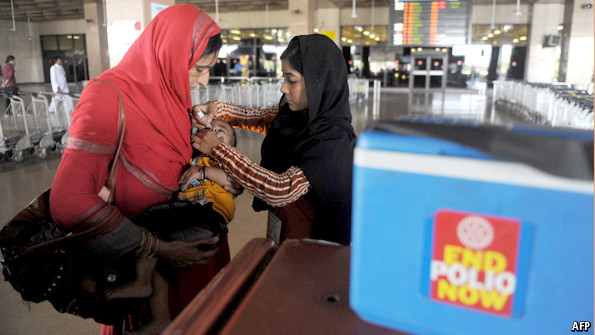
Wednesday, May 21, 2014

IN 1988 polio caused huge concern: the disease, which leaves one victim in every 200 paralysed, was prevalent in more than 125 countries which together counted 350,000 cases annually. A quarter of a century and 2.5 billion vaccinated children later, the virus looked close to extinction: just five countries reported new instances of polio in 2012. The World Health Organisation (WHO) declared that by 2018 it should be history, alongside smallpox, another once-feared killer. And in March of this year India, which five years ago accounted for nearly half of all cases, was declared polio-free.
Yet the prospect that the whole world will achieve the same feat is now slipping away. In a change of tune, the WHO earlier this month declared polio a "public health emergency of international concern"—something it has done only once before, with the pandemic flu in 2009. So far this year 77 polio cases have been reported, up from 33 in the same period of 2013, despite it being the disease’s low season. These are spread across eight countries: Pakistan, Afghanistan, Cameroon, Equatorial Guinea, Ethiopia, Iraq, Syria and Nigeria. Laboratory analyses of faecal samples show that three of the countries (Pakistan, Syria and Cameroon) have recently transmitted the virus to neighbours—particularly alarming for the WHO. Problems persist elsewhere too. Somalia had a case of polio as recently as December, and Israel has detected the virus in its sewage system.
Although children are more likely to catch polio, adults are helping to spread it. The WHO has asked all ten affected countries to encourage departing travellers to get vaccinated and told the three known to have exported it to refuse exit to anyone without a vaccination certificate. The fear is that the disease will spread to other politically unstable countries. The approach of the Asian monsoon season adds urgency: polio is transmitted more easily in humid conditions, and when already poor sanitations systems are overwhelmed.
Heidi Larson of the London School of Hygiene and Tropical Medicine puts the blame for fuelling the transmission of polio largely on Pakistan. It is the big backslider, accounting for the vast majority of cases (61 out of 77) this year, compared with just eight during the same period in 2013.
In recent years Pakistan has allowed some of its most lawless regions to become havens for the virus. Hardly any of the 290,000 children in the two Waziristans, for example, have been vaccinated since 2012—the year militant chieftains declared a ban on the work of vaccinators, most likely in retaliation for American drone strikes. The fact that the CIA is said to have used a fake vaccine campaing in the search for Osama Bin Laden has not helped the cause. (In response to a wave of deadly attacks on polio workers in the region, the American government said yesterday that the CIA has ended the use of vaccine programmes in its spying operations.) In addition, people in the region are exceptionally mobile, with large in- and outflows of jihadists, aid workers and refugees, all acting as possible couriers of the disease. Many of the strands found around the world, including in Israel and Afghanistan, originated in Pakistan.
Beyond the steps proposed by the WHO, more health diplomacy and intelligent security efforts could help curb polio’s spread by facilitating medical activities in conflict zones, says Dr Larson. But she admits that the Pakistani situation is far more complex than the one in northern Nigeria during the region’s polio-vaccination boycott in 2003-04, which Dr Larson helped to end as part of UNICEF’s negotiating team. Internal conflict and tribal loyalties in Pakistan are complicating matters.
It is critical to combat polio quickly, while its resurgence is still small. The downside of the disease becoming so rare—even with the increase in the number of cases this year, the disease’s occurrence has diminished by over 99% since 1988—is that people’s natural resistance has also been reduced. A failure to eradicate the disease could lead to as many as 200,000 new cases per year within the next decade, warns the Gates Foundation, which spends a lot of money to fight polio. This would put huge strain on medical budgets: a worldwide vaccination campaign, for instance, costs around $1 billion per year. But as Benjamin Neuman, a virologist at the University of Reading, points out, "you need to eradicate wars before you can eradicate polio."